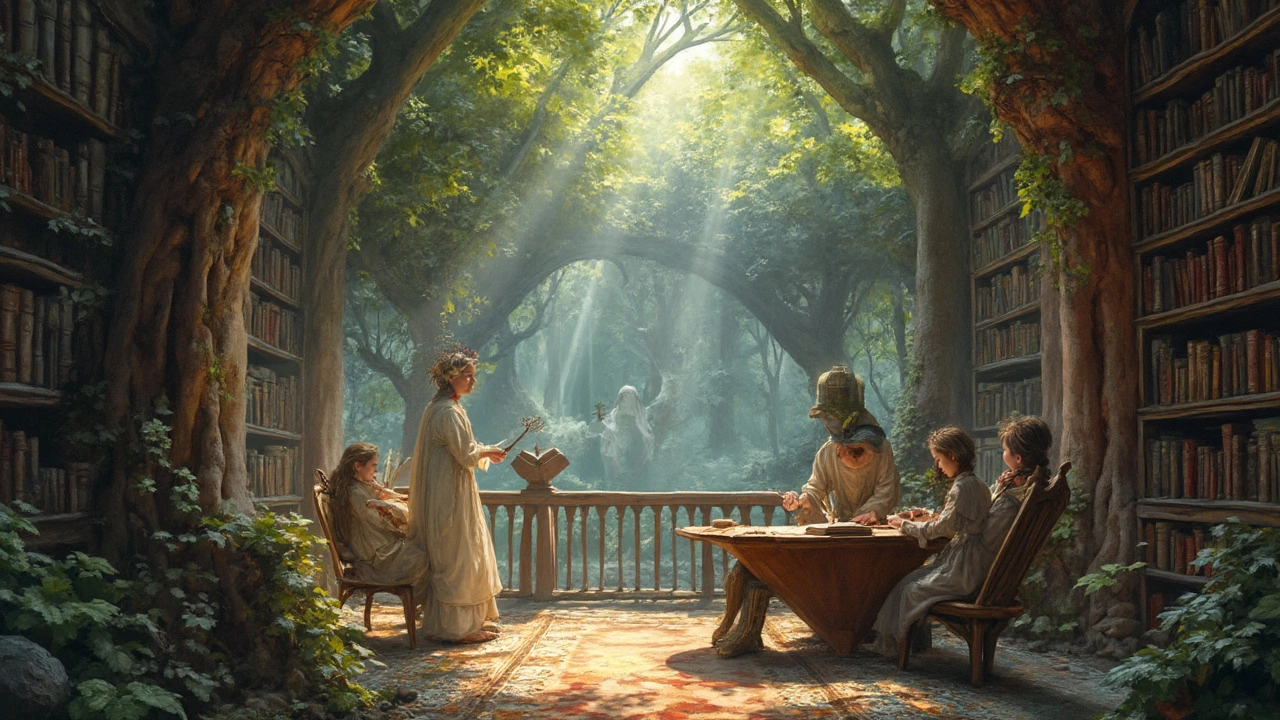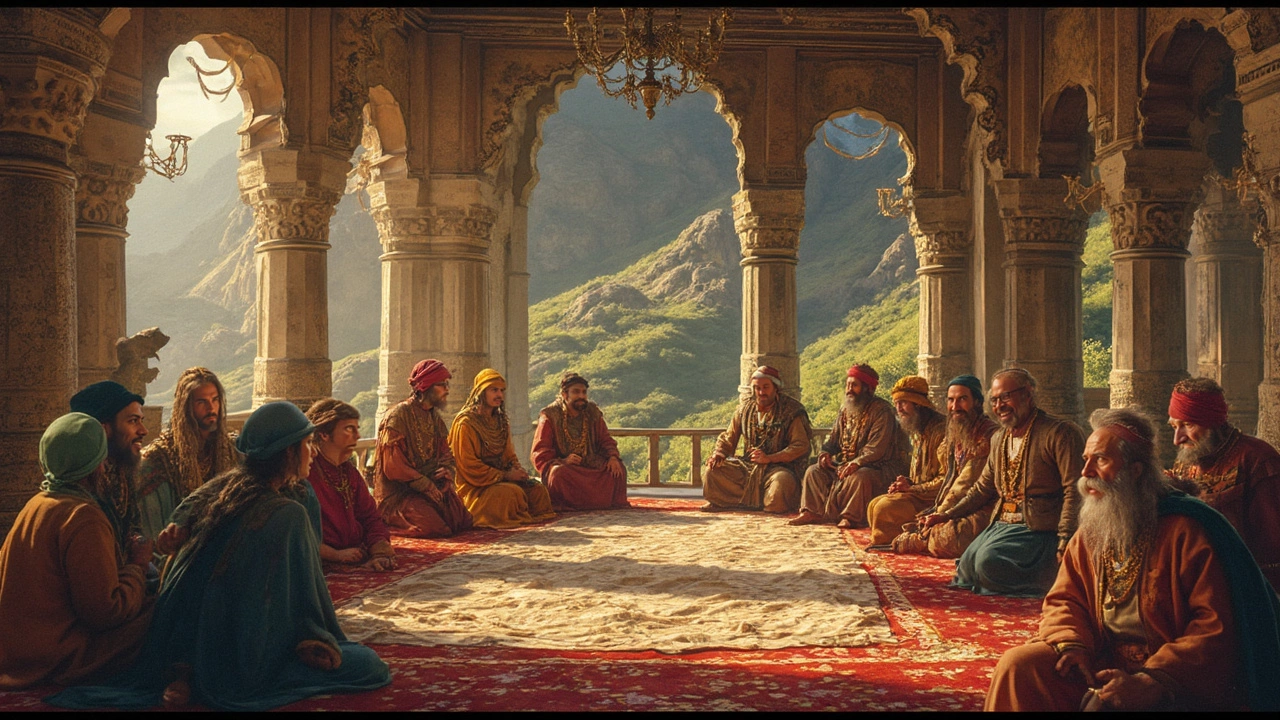
Let's kick things off with a little myth-busting. When people chat about the 'godfather of fantasy,' it's not as clear-cut as you might think. Yes, J.R.R. Tolkien often wears that crown, thanks to his epic saga, The Lord of the Rings. But is he the only contender? Well, not quite.
C.S. Lewis, Tolkien's close mate, deserves a nod too. His Narnia series has whisked countless readers away into enchanted wardrobes. So, how do we decide who's the real champ?
Start by tracing their influence. Fantasy stories today—think epic quests, mythical creatures, and bewitched lands—owe a lot to these two legends. Whether you're flipping through the pages of Game of Thrones or Harry Potter, their echoes are everywhere. Stick around as we delve deeper and uncover the fascinating foundations of fantasy literature.
- Defining the Original Godfather
- Two Titans: Tolkien vs. Lewis
- Impact on Modern Fantasy
- Hidden Gems in Fantasy Literature
- Character Development Techniques
- Building Fantastical Worlds
Defining the Original Godfather
So, who really stands as the godfather of fantasy? When you're throwing around titles like these, it’s a good idea to start with what both readers and critics often say. The name that comes up the most? J.R.R. Tolkien.
Tolkien didn’t just spin a tale in The Lord of the Rings; he created a whole universe with its own languages, cultures, and history. The depth and complexity of Middle-earth set a standard in the genre that's tough to beat. Before Tolkien, such detailed world-building wasn’t typical in fantasy literature.
The Tolkien Revolution
Published in the mid-20th century, his works arrived when the world needed tales of heroism and adventure. His influence has been so profound that many modern fantasy novels still draw on his themes and settings—elves, dwarves, and epic battles.
Is that enough to crown him the 'godfather'? Many folks believe so because he laid down the tracks for the fantasy train we ride today.
Is There Another Contender?
But don’t count out C.S. Lewis. His Narnia books have been transporting young minds to magical realms just as effectively as Tolkien. Lewis' use of allegory and accessible storytelling style made his books engaging for both kids and adults.
When it comes down to it, calling either author the original godfather can feel like choosing between two best friends. They both made fantasy what it is today, each contributing their unique spin.
So instead of picking a definitive godfather, maybe the real win is seeing how their legacies continue to inspire new generations of readers and authors alike. That alone is worth celebrating!
Two Titans: Tolkien vs. Lewis
When talking about the legends of fantasy, J.R.R. Tolkien and C.S. Lewis stand as towering figures. Not only did they pave the way for modern fantasies, but they also shared an interesting friendship that fueled their creativity.
J.R.R. Tolkien: Creator of Middle-earth
Tolkien is best known for his work on The Lord of the Rings and The Hobbit. What makes Tolkien fascinating is his detailed world-building. Middle-earth isn't just a background—it's a living, breathing world with its own languages, history, and cultures. Fun fact? He actually invented several languages for his characters to speak!
So, why does Tolkien often get called the godfather of fantasy? Simply put, he set the standard for epic fantasy. His intricate plots and rich landscapes challenged readers to think of fantasy as serious literature.
C.S. Lewis: The Mind Behind Narnia
On the flip side, there's C.S. Lewis. His Narnia series might have fewer pages than Tolkien's works, but they're packed with adventure and moral lessons. Who could forget the magic wardrobe portal or Aslan the wise lion?
Lewis' stories are more allegorical, often infused with his own beliefs and philosophies, making them a different yet equally captivating experience for readers. Despite their differences in style, both authors brought something unique to the table.
A Tale of Friendship and Influence
It's no secret these two were friends. As part of an informal literary group called 'The Inklings,' they often critiqued each other's work. Imagine two literary giants sharing notes!
Even the best pals can have their differences. Lewis found Tolkien's plots overly long, while Tolkien suspected Lewis of being too preachy. Yet, their mutual respect helped them hone their craft, creating stories that have stood the test of time.
Both authors have huge legacies. While Tolkien gave depth to fantasy worlds, Lewis made them accessible and enchanting. Together, they shaped what we know today as the fantasy genre.
Impact on Modern Fantasy
Alright, let's talk about how these fantasy legends left their mark on the world. When you crack open a fantasy novel today, be it a tale of dragons or wizards, there's a good chance that the author was influenced by either J.R.R. Tolkien or C.S. Lewis. These guys set the groundwork for how we tell stories in fantastical settings.
Tolkien went above and beyond with his world-building. I mean, he didn't just create a storyline; he crafted entire languages, cultures, and histories. This level of detail inspired a whole generation of writers to dig deeper into their worlds. Ever noticed how fantasy novels these days often come with detailed maps and extensive backstories? You can thank Tolkien for that tradition.
On the flip side, Lewis took a slightly different approach but was equally impactful. His Narnia series was more allegorical, using fantasy to explore themes about morality and religion. Many modern fantasy authors blend deeper meanings or messages into their stories, a nod to Lewis's influence.
Let's sprinkle in some fun facts: Did you know that The Lord of the Rings has sold over 150 million copies worldwide? Or that The Chronicles of Narnia has been translated into 47 different languages? That's how far these stories have traveled, making them staples of any fantasy collection.
| Series | Copies Sold | Languages Translated |
|---|---|---|
| The Lord of the Rings | 150 million+ | 38 |
| The Chronicles of Narnia | over 100 million | 47 |
Thanks to these trailblazers, new authors have a solid foundation to build on, giving us diverse stories that continue to surprise and delight. Whether you're into the epic scale of George R.R. Martin's works or the magical twists of J.K. Rowling, the legacies of Tolkien and Lewis are alive and kicking in every page.

Hidden Gems in Fantasy Literature
Alright, so we all know the big hitters like Tolkien and Lewis. But let's explore some lesser-known yet fantastic works that have enriched the fantasy novels shelf.
1. The Neverending Story by Michael Ende
This isn't just a book you've seen adapted into a movie. Ende's imaginative world creates a rich tapestry of adventure and introspection. As you leaf through its pages, you're not just reading a story; you're becoming part of it. Ende once remarked,
"The journey never ends, and the destination is always the journey itself."
2. The Farseer Trilogy by Robin Hobb
A masterclass in character development, these books draw you in with their raw human emotions and intricately woven plot. Dive into Fitz's world, where being a royal bastard is just the beginning of his problems.
3. The Earthsea Cycle by Ursula K. Le Guin
Le Guin’s story offers a different flavor of magic than the usual wands and spells. Her books are deeply philosophical and explore themes of power and responsibility through the eyes of Ged, a young wizard in training. As she said,
"It's good to have an end to journey toward, but it's the journey that matters."
4. C.S. Lewis’s Till We Have Faces
Okay, Lewis sneaks back into our list, but this is no ordinary tale. Reimagining the myth of Cupid and Psyche, it's a sophisticated blend of human psyche and divine intrigue. Definitely a hidden gem begging to be discovered.
These lesser-known gems have inspired modern authors and retain a cultural significance, no matter how hidden they might seem. For a true fantasy aficionado, these novels aren't just stories; they are a journey through worlds waiting to be explored.
Character Development Techniques
Crafting memorable characters is where the magic truly happens in any fantasy novels. But how do these legendary authors like Tolkien and Lewis breathe life into their cast?
Consistency is Key
One thing you'll notice is that their characters behave in line with their established traits and backstories. In The Hobbit, you'll see Bilbo Baggins' journey from a cautious hobbit to a courageous hero. This consistency makes them believable throughout their adventures.
Creating Relatable Backstories
Another trick is giving characters relatable pasts, even in a fantasy setting. Take Eowyn from The Lord of the Rings. Her longing for freedom and recognition speaks to anyone who's ever felt constrained by their circumstances. It’s these details that help us connect with characters on a personal level.
Dynamic Growth
Great fantasy stories are filled with characters who evolve. Just like real folks, fictional characters should grow and adapt. Look at Edmund Pevensie in the Narnia series. His redemption arc from a spiteful boy to a noble king adds depth to his character and the overall story.
Flaws Make Them Real
No one enjoys a perfect character; their flaws make them relatable. Aragorn, for example, faces self-doubt and struggles with his destiny. These imperfections make him more real and engaging.
Characters in the Fantasy Genre
Feeling all of these techniques can be like spinning plates, but it's what makes the best characters endure. If you’re penning your own story, consider blending consistency, compelling backstories, growth, and a touch of human flaw to create characters readers won't forget easily.
Building Fantastical Worlds
Alright, let's get into how these fantasy masters crafted worlds that pull us into their pages. Whether you're exploring Middle-earth or wandering through Narnia, these worlds aren't just backdrops—they're as real and vivid as the characters themselves.
Strong Foundations
The secret sauce? Detailed and consistent rules. In Tolkien's Middle-earth, every creature, language, and map has its place, creating a believable realm. This depth lets readers dive in and feel like they're part of the adventure. Meanwhile, C.S. Lewis used a simpler approach with Narnia, but maintained the magic with consistent fantasy rules—like time moving differently there compared to the real world.
Character and Culture
What else keeps these worlds ticking? Characters and their cultures. Tolkien was meticulous about the cultures of his Elves, Dwarves, and Men, each with their own histories and customs. Narnia isn't left out either; different lands with unique creatures, like talking animals, give it that touch of wonder.
Blending Fantasy and Realism
Even in the realm of fantasy, a sprinkle of realism helps. Tolkien often based his settings on real locations. Did you know Rivendell might have been inspired by the stunning Swiss landscapes he visited?
| Author | World | Unique Elements |
|---|---|---|
| J.R.R. Tolkien | Middle-earth | Languages, rich histories |
| C.S. Lewis | Narnia | Talking animals, time manipulation |
So, next time you crack open a fantasy novel, look for those details that make the worlds come alive. Who knows? Maybe it’ll spark some ideas for your own storytelling adventures.


